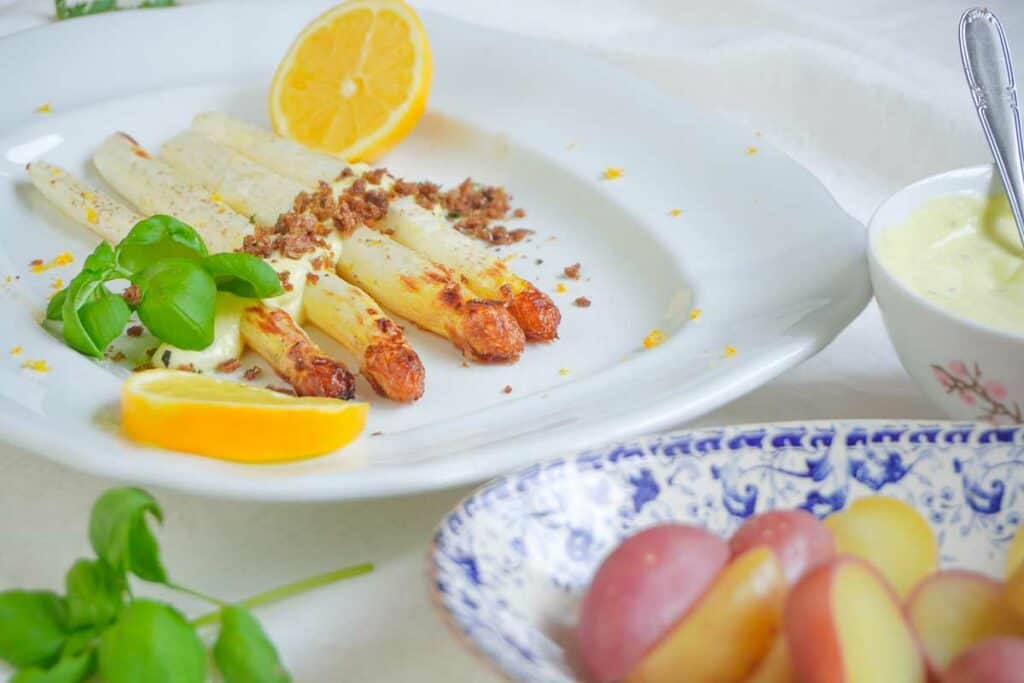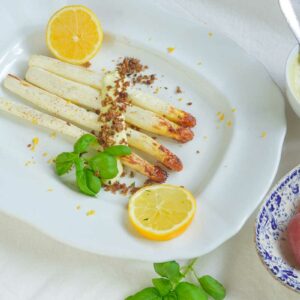
Roasted asparagus
Roasted asparagus are a treat, and with the advent of spring, there’s no better way to indulge than with the decadence of one of the season’s culinary superstars: white asparagus. Known as the ‘white gold’ (and with good reason!), asparagus is an elegant and nutritious ingredient that can be prepared in myriad ways. Though boiling is usually given preference, in this recipe we roast the asparagus to perfection, intensifying their natural sweetness while imparting a delightful caramelized touch, elevating them to a whole new level of deliciousness.
The tender spears are served with a velvety ‘Hollandaise’ (a classic French sauce calling for butter and eggs), which we’ve easily veganized with simple ingredients rather than the more complicated versions using cashews (which impart too much of a nutty flavor) or thickened with (chickpea) flour or cornstarch (more akin to a béchamel). Our soy milk and olive oil-based version results in a fresher and brighter ‘Hollandaise’ that can easily be customized to suit your tastes—whether you prefer it infused with different herbs (tarragon would be a fantastic option!), or brightened up with a spritz of lemon.
For an extra delicious touch, the dish is scattered with tiny nuggets of golden pangrattato (crisp breadcrumbs seasoned with zesty lemon, garlic, parsley and a whisper of chili flakes), adding a burst of flavor and a satisfying crunch to every bite. We’ve used ordinary whole-wheat sliced bread, which we all tend to readily have access to. Just make sure the bread is somewhat stale and dry, not fresh. And the best part? Any leftover pangrattato can be repurposed and sprinkled over pasta!
To serve the asparagus, drizzle with the velvety ‘hollandaise,’ crown generously with the crisp pangrattato, and finish with a squeeze of lemon, if desired, for that extra zing. Pair this beautiful spring meal with steamed new potatoes and a chilled bottle of Riesling or Muscat d’Alsace for an unforgettable dining experience that celebrates the season’s bounty in style.
What is pangrattato?
Pangrattato is an Italian breadcrumb topping that has become increasingly popular in recent years. It is made by toasting breadcrumbs in olive oil with seasonings, and is often used as a crunchy topping for pasta dishes, roasted vegetables, or soups. The name “pangrattato” means “grated bread” in Italian, and it has its roots in southern Italian cuisine, where it was traditionally used as a way to use up stale bread. It is sometimes also referred to as “poor mans Parmesan”. This simple yet delicious ingredient adds a crunchy texture and nutty flavor to a variety of dishes, ranging from pasta and salads to soups and stews. Find more info on pangrattatto and another pangrattato recipe here.

Roasted asparagus with basil ‘Hollandaise’ & zesty pangrattato
Equipment
- 1 stick blender
- 1 sheet of parchment paper
Ingredients
For the asparagus:
- 400 g white asparagus peeled and woody ends (approx. 2 cm) removed
- 1 ½ tbsp quality extra virgin olive oil
- fine sea salt
- freshly cracked pepper
For the pangrattato:
- 2 slices stale whole-wheat bread with crusts, torn
- 2 tbsp roughly chopped parsley
- 1 clove garlic
- 2 tbsp quality extra virgin olive oil
- fine sea salt
- freshly cracked pepper
- 1 pinch of chili flakes
- ½ lemon, it's grated zest unwaxed or organic
For the ‘Hollandaise’
- 100 ml soy milk
- 1 tbsp white wine vinegar
- 1 tsp Dijon mustard
- 1 pinch of fine sea salt
- 1 pinch of turmeric
- 125 ml quality extra virgin olive oil
- 10 basil leaves
Instructions
- Preheat the oven to 180°C (fan) and line a baking tray with parchment paper. Place the asparagus on the baking tray, drizzle with the olive oil, and using your hands, make sure all the spears are evenly coated. Season with salt and pepper. Roast for 15-20 minutes, depending on the thickness of your asparagus. After about 12 minutes, check the asparagus for doneness.400 g white asparagus, 1 ½ tbsp quality extra virgin olive oil, fine sea salt, freshly cracked pepper
- In the meantime, make the pangrattato. Put the bread, parsley and garlic in a small food processor and blitz until you have a nicely rough but not too chunky consistency.2 slices stale whole-wheat bread, 2 tbsp roughly chopped parsley, 1 clove garlic
- Heat the olive oil in a frying pan and fry the pangrattato, seasoning it with salt, pepper and chili flakes, for approximately 5 minutes, until golden and crisp.2 tbsp quality extra virgin olive oil, fine sea salt, freshly cracked pepper, 1 pinch of chili flakes
- Take the pan off the heat and stir in the lemon zest. Transfer the pangrattato to a bowl and set aside.½ lemon, it's grated zest
- Now make the basil ‘hollandaise.’ Place the soy milk, vinegar, turmeric mustard and salt in a jug. Slowly start pouring in the oil while using a stick blender to thicken the sauce.100 ml soy milk, 1 tbsp white wine vinegar, 1 tsp Dijon mustard, 1 pinch of fine sea salt, 1 pinch of turmeric
- When you’ve added about half the oil, add the basil. Continue blending until the sauce is emulsified, and taste to adjust the seasoning if necessary.125 ml quality extra virgin olive oil, 10 basil leaves
- Transfer the ‘hollandaise’ to a small saucepan and warm very briefly while whisking. You just want to take the cold out of the sauce, not cook it.
- Serve the roasted asparagus with the basil ‘hollandaise,’ the pangrattato, lemon wedges and steamed new potatoes.
Notes
- Before cooking, white asparagus must be thinly peeled (starting under the tips) and the woody ends (approx. 2 cm) removed. Save the peels and ends to make soup.
- Hollandaise is traditionally served warm, but you can also serve our version cold. Leftovers can be stored in the fridge for up to three days and used as a dip for a crudités platter, as a base for dressings or to serve with baked potatoes.
- Asparagus is best when locally harvested and consumed soon after purchase. To determine freshness, make sure the tips are smooth and the stalks squeak when rubbed together.

